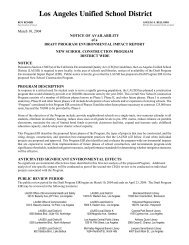Site-Specific Health and Safety Plan (HASP) - Laschools.org
Site-Specific Health and Safety Plan (HASP) - Laschools.org
Site-Specific Health and Safety Plan (HASP) - Laschools.org
Create successful ePaper yourself
Turn your PDF publications into a flip-book with our unique Google optimized e-Paper software.
specific gravity of 1 for water, then the weight <strong>and</strong> the volume of water are<br />
numerically equal.<br />
6. Take a glass column equipped with a stopcock at the bottom (such as a buret),<br />
<strong>and</strong> place a glass wool plug at the bottom of the column.<br />
7. Weigh out a 50 gram sample (W3) of the wet soil <strong>and</strong> transfer it into the<br />
column above the glass wool plug.<br />
8. Compact the soil in the column as much as possible.<br />
9. Add 100 mL laboratory pure water to the top of the column, open the<br />
stopcock, <strong>and</strong> collect the effluent from the column.<br />
10. Wait for the water to nearly pass entirely through the column. If the water<br />
coming off the column is colored (any shade of yellow through rust) do not<br />
collect any sample for analysis, just collect the total effluent. When the water<br />
is no longer colored, start collecting the samples for analysis at 100 mL<br />
intervals.<br />
11. Repeat steps 9 <strong>and</strong> 10 until hexavalent chromium is no longer detected in the<br />
1 mL taken for testing.<br />
12. Pass a maximum of 500 mL before setting the collected samples for testing<br />
for hexavalent chromium. Run the last collected fraction first. If it shows<br />
hexavalent chromium, don't bother with testing the other samples. If it doesn't<br />
show hexavalent chromium, continue testing the samples in reverse order.<br />
13. When hexavalent chromium is no longer detectable in the leachate, measure<br />
the total volume (VL) of water that was passed through the column, <strong>and</strong><br />
determine the hexavalent chromium concentration in the combined leachates<br />
(CL).<br />
14. Determine the volume of water held by the sample in the column<br />
V = W3 x [(W1 – W2)/W1]<br />
15. Determine the concentration of the hexavalent chromium in the water that was<br />
held by the sample<br />
C = CL x VL/V<br />
16. If the determined hexavalent chromium in step 14 is significantly greater than<br />
the concentration of the hexavalent chromium in the groundwater, then a<br />
significant contribution is due to adsorbed hexavalent chromium. If the<br />
determined hexavalent chromium in step 14 is approximately equal to or is<br />
342







